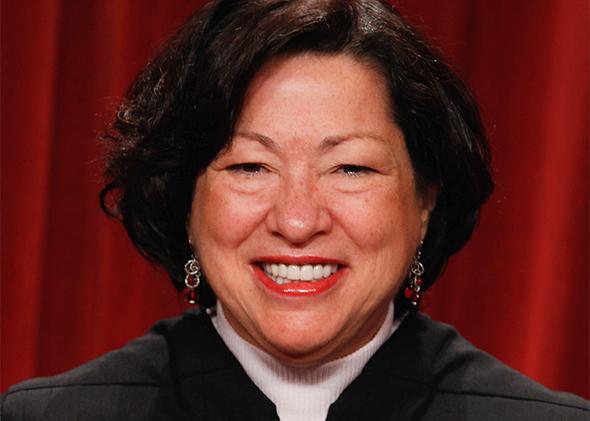How does the Supreme Court solve a division problem that Congress has dropped in its lap? The justices wrestled with that question Wednesday during the arguments in a case about how to award restitution to child pornography victims. They were struggling because most of them didn’t seem to see an easy or completely satisfying answer.
The Violence Against Women Act provides that people whose images are used in child pornography can sue the viewers of the pictures and videos—the people (mostly men) who are convicted for possessing them. They can also sue the distributors and the producers. But Wednesday’s case is harder because it’s an appeal by Doyle Randall Paroline, a man who was found guilty of having two illegal pictures of a woman who goes by the name of Amy in court documents, as part of a larger collection of images. Paroline’s is one of more than 3,200 criminal cases in the United States that involves Amy’s image. For the harm of this continuing viewing—for knowing that people are seeing pictures of her being raped as an 8-year-old girl, as Justice Antonin Scalia put it Wednesday—she claims a total of $3.4 million in damages, covering counseling, lost income, and attorneys’ fees. So, for how much of that total should Paroline be held responsible?
His lawyer told the court the answer is nothing, because Amy didn’t prove that he personally caused her harm. Amy’s answer is everything—the whole $3.4 million—because Paroline contributed to the aggregate harm. It should be his burden, her lawyers say, to go after the other thousands of defendants for their contributions, under a theory called joint and several liability. This is the theory that allows a plaintiff harmed by a polluted lake in which several companies have dumped waste to sue one big one for everything and then expect that defendant to get the others to share the cost.
“How about something in between?” Scalia asked the lawyer representing the Department of Justice, which is in the case because the government has to ask for restitution upon winning a conviction for child pornography. He wasn’t the only justice looking for middle ground. Most of them seemed to be hunting for it. Does it really make sense to say that Paroline’s viewing of two images caused $3.4 million in harm to Amy? That was cause for a lot of skepticism. But I counted zero votes for awarding her nothing because she is harmed by more than one person—that can’t be what Congress intended, the justices agreed.
The problem was that how to get to “something in between” remained elusive. The Department of Justice wants district court judges to make “reasonable” estimations in each case. But that language is nowhere in the statute, and the justices couldn’t figure out what would ground it. Didn’t this amount to starting with one judge “who plucks an initial number out of the air?” Justice Elena Kagan asked DOJ. Scalia joined Kagan. “I want to go along with you. This is a bad guy who ought to be punished,” he said to the DOJ lawyer. “But there’s such a thing as due process. I have no idea what he’s going to be socked with.”
The government tried to argue that its approach, of reasonable estimates by district court judges, comes out of the “development of tort law.” Justice Anthony Kennedy squashed this. “I’m not going along with you” on this notion of modern tort law, he said. “That’s nonsense.”
Justice Stephen Breyer pushed a different approach: “Can we say … leave it to the Sentencing Commission. That’s their job. Now, can we say that?” he asked. Breyer was talking about the U.S. Sentencing Commission, which Congress established in 1984 to make recommendations to the judicial branch on matters of punishment. There’s nothing in the Violence Against Woman Act assigning this particular responsibility to the commission, though.
What about the alternative Amy wants—liability in the “full amount,” as the statute says, for each defendant, and then they go after one another for contributions up to the $3.4 million cap, in Amy’s case? Justice Sonia Sotomayor was the member of the court I heard fully embrace this. She said to the DOJ lawyer: “That statutory language—as crazy as it seems to, to you—would seem to compel joint and several liability.” But Scalia remained unhappy. “He had two pictures,” he said of Paroline. “He’s guilty of a crime.” But to sock him with all of her psychological costs because he had two pictures? “Congress couldn’t have intended that.”
“Congress could have,” Paul Cassell, Amy’s lawyer, responded simply. And if you buy his theory of joint and several liability, and contribution, then that’s the answer. Ginsburg, Alito, and Sotomayor all had questions about how this would actually work. “How does the defendant seek contributions?” Ginsburg asked. Cassell’s answer is that defendants like Paroline start suing one another. “Then the burden is on the guilty criminal rather than the innocent victim,” he said. And he promised that Amy, who to date has collected half of the $3.4 million in damages she claims, would be able to finish collecting—and be made whole, in the language of the law—in two or three years. Other victims can follow her to court, as a few already have.
I wrote about Amy and a second victim, who goes by Nicole, for the New York Times Magazine a year ago, and they both felt nervous about being the first to come forward and ask for restitution. It’s a hard role to play when your biggest fear is being exposed. But they’ve also taken increasing pride about paving the way for other victims to win compensation, especially to pay for counseling, which has helped both of them overcome their experiences of trauma. Both Amy and Nicole attended the argument on Wednesday. Afterward, Amy told me she was thrilled. And Nicole texted me to say, “I felt like the judges really grasped the issues and tried to hash them out.”
